Application of Fuzzy and Rough Sets to Environmental Zonation for Concrete Durability: A Case Study of Shaanxi Province, China
Abstract
:1. Introduction
2. Analysis of Durability Environmental Conditions in Shaanxi Province
2.1. Atmospheric Temperature
2.1.1. Annual Average Temperature
2.1.2. Average Monthly Temperature
2.2. Precipitation
2.3. Corrosive Gases in the Atmosphere
2.3.1. Carbon Dioxide
2.3.2. Sulfur Dioxide and Nitrogen Dioxide
2.4. Acid Rain
3. Environmental Zonation for Concrete Durability in Shaanxi Province
3.1. Principles of Environmental Zonation for Concrete Durability
3.2. Indexes of Environmental Zonation
3.3. Environmental Zonation for Concrete Durability
3.3.1. Fuzzy Cluster Analysis and the Theory of the Rough Set
Fuzzy Cluster Analysis
Rough Set theory
3.3.2. Weight Distribution of the Index of Environmental Zonation for Concrete Durability
3.3.3. Environmental Zonation for Concrete Durability in Shaanxi Province
3.3.4. Environmental Conditions of Each Zone
Freeze-Thaw Cycle Zone (Zone I)
Neutralization–Freeze-Thaw Interaction Zone (Zone II)
Neutralization Zone (Zone III)
4. Discussion
5. Conclusions
- (1)
- The environmental conditions of concrete structures in Shaanxi Province were investigated, including atmospheric temperature, precipitation, corrosive gases in the atmosphere, and acid rain. Generally speaking, the annual average temperature in Shaanxi Province is higher in the south and lower in the north, which has increased slightly in the past half century. The annual precipitation is more in the south than that in the north, and has decreased slightly in recent years. The corrosive gas emissions show an upward trend before 2011 and a downward trend after 2011, which is closely related to economic development and environmental governance.
- (2)
- According to the survey results of durability of existing industrial buildings, residential buildings, roads, and bridges in Shaanxi Province, the main factors affecting the durability of concrete structures are freeze-thaw cycles and the concrete neutralization caused by carbonation and acid rain erosion. According to the deterioration mechanism of concrete durability, the zoning indexes are determined as annual freeze-thaw cycles, annual precipitation, average temperature in July, and annual acid rainfall.
- (3)
- Fuzzy clustering analysis and rough set theory were introduced into the environmental zonation for concrete durability, and the weights of durability zoning indexes were calculated. Based on this, Shaanxi Province was zoned into three first-level zones, namely the Freeze-Thaw Cycle Zone, the Neutralization–Freeze-Thaw Interaction Zone, and the Neutralization Zone, and these three zones were then subdivided into nine second-level zones. The main reasons for durability deterioration of concrete structures were analyzed according to the environmental characteristics of each zone in the zoning map.
Author Contributions
Funding
Acknowledgments
Conflicts of Interest
References
- Andersson, D.E.; Andersson, A.E. Sustainability and the Built Environment: The Role of Durability. Sustainability-Basel 2019, 11, 4926. [Google Scholar] [CrossRef] [Green Version]
- Ashraf, W. Carbonation of cement-based materials: Challenges and opportunities. Constr. Build. Mater. 2016, 120, 558–570. [Google Scholar] [CrossRef]
- Liu, H.; Luo, G.; Wang, L.; Gong, Y. Strength Time-Varying and Freeze-Thaw Durability of Sustainable Pervious Concrete Pavement Material Containing Waste Fly Ash. Sustainability-Basel 2019, 11, 176. [Google Scholar] [CrossRef] [Green Version]
- Kessler, S.; Thiel, C.; Grosse, C.U.; Gehlen, C. Effect of freeze-thaw damage on chloride ingress into concrete. Mater. Struct. 2017, 50, 121. [Google Scholar] [CrossRef]
- Gong, F.; Maekawa, K. Multi-scale simulation of freeze-thaw damage to RC column and its restoring force characteristics. Eng. Struct. 2018, 156, 522–536. [Google Scholar] [CrossRef]
- Chen, M.; Wang, K.; Xie, L. Deterioration mechanism of cementitious materials under acid rain attack. Eng Fail Anal 2013, 27, 272–285. [Google Scholar] [CrossRef]
- Kim, T.H.; Chae, C.U. Environmental impact analysis of acidification and eutrophication due to emissions from the production of concrete. Sustainability-Basel 2016, 8, 578. [Google Scholar] [CrossRef] [Green Version]
- Zhang, P.; Wittmann, F.H.; Vogel, M.; Müller, H.S.; Zhao, T. Influence of freeze-thaw cycles on capillary absorption and chloride penetration into concrete. Cem. Concr. Res. 2017, 100, 60–67. [Google Scholar] [CrossRef]
- Otieno, M.; Beushausen, H.; Alexander, M. Chloride-induced corrosion of steel in cracked concrete—Part I: Experimental studies under accelerated and natural marine environments. Cem. Concr. Res. 2016, 79, 373–385. [Google Scholar] [CrossRef]
- Cheng, Y.; Zhang, Y.; Tan, G.; Jiao, Y. Effect of Crack on Durability of RC Material under the Chloride Aggressive Environment. Sustainability-Basel 2018, 10, 430. [Google Scholar] [CrossRef] [Green Version]
- Müllauer, W.; Beddoe, R.E.; Heinz, D. Sulfate attack expansion mechanisms. Cem. Concr. Res. 2013, 52, 208–215. [Google Scholar] [CrossRef]
- Ortega, J.M.; Esteban, M.D.; Williams, M.; Sánchez, I.; Climent, M.Á. Short-term performance of sustainable silica fume mortars exposed to sulfate attack. Sustainability-Basel 2018, 10, 2517. [Google Scholar] [CrossRef] [Green Version]
- Ministry of Construction of the PRC. GB 50010-2010, Code for Design of Concrete Structures; China Architecture & Building Press: Beijing, China, 2015.
- Ministry of Construction of the PRC. GB/T50476-2019. Standard for Design of Concrete Structure Durability; China Architecture & Building Press: Beijing, China, 2019.
- European Committee for Standardization (CEN). EN 1992-1-1, Euro-code 2: Design for Concrete Structures-Part 1-1: General Rules and Rules for Buildings; CEN: London, UK, 2004. [Google Scholar]
- Jin, W.; Lv, Q. Durability zonation standard of concrete structure design. J. Southeast Univ. Engl. Ed. 2007, 23, 98–104. [Google Scholar]
- Wu, H.; Jin, W.; Yan, Y.; Xia, J. Environmental zonation and life prediction of concrete in frost environments. J. Zhejiang Univ. Eng. Sci. 2012, 46, 650–657. [Google Scholar]
- Seo, S.; Lee, B.; Won, J. Comparative Analysis of Economic Impacts of Sustainable Vertical Extension Methods for Existing Underground Spaces. Sustainability-Basel 2020, 12, 975. [Google Scholar] [CrossRef] [Green Version]
- Li, F.; Zhou, M.; Hu, M. Climate change in different geographical units and its impact on land production potential: A case study of Shaanxi Province, China. Env. Sci. Pollut. Res. 2019, 26, 22273–22283. [Google Scholar]
- National Meteorological Information Center. China Meteorological Data Sharing Service System. Available online: http://data.cma.cn/ (accessed on 25 February 2020).
- Compilation Committee of Local Chronicles of Shaanxi Province. Shaanxi Statistical Yearbook. Available online: http://www.sxsdq.cn/sqzlk/sxnj/ (accessed on 25 February 2020).
- Papadakis, V.G.; Vayenas, C.G.; Fardis, M.N. Experimental investigation and mathematical modeling of the concrete carbonation problem. Chem. Eng. Sci. 1991, 46, 1333–1338. [Google Scholar] [CrossRef]
- Chen, T.; Kuschner, W.G.; Gokhale, J.; Shofer, S. Outdoor air pollution: Nitrogen dioxide, sulfur dioxide, and carbon monoxide health effects. Am. J. Med Sci. 2007, 333, 249–256. [Google Scholar] [CrossRef]
- Khan, R.R.; Siddiqui, M. Review on effects of particulates; sulfur dioxide and nitrogen dioxide on human health. Int. Res. J. Env. Sci. 2014, 3, 70–73. [Google Scholar]
- Burns, D.A.; Aherne, J.; Gay, D.A.; Lehmann, C.M. Acid rain and its environmental effects: Recent scientific advances. Atmos. Environ. 2016, 146, 1–4. [Google Scholar] [CrossRef] [Green Version]
- Müller, H.S.; Haist, M.; Vogel, M. Assessment of the sustainability potential of concrete and concrete structures considering their environmental impact, performance and lifetime. Constr. Build. Mater. 2014, 67, 321–337. [Google Scholar] [CrossRef]
- Hooton, R.D.; Bickley, J.A. Design for durability: The key to improving concrete sustainability. Constr. Build. Mater. 2014, 67, 422–430. [Google Scholar] [CrossRef]
- Alexander, M.; Bentur, A.; Mindess, S. Durability of Concrete: Design and Construction. CRC Press Taylor& Francis Group: Boca Raton, FA, USA, 2017; Volume 20, pp. 1–324. [Google Scholar]
- Menz, F.C.; Seip, H.M. Acid rain in Europe and the United States: An update. Env. Sci. Policy 2004, 7, 253–265. [Google Scholar] [CrossRef]
- Timm, H.; Borgelt, C.; Döring, C.; Kruse, R. An extension to possibilistic fuzzy cluster analysis. Fuzzy Set Syst. 2004, 147, 3–16. [Google Scholar] [CrossRef]
- Xie, J.; Ping, C. Fuzzy Mathematics Method and Applications, 4th ed.; Huazhong University of Science & Technology Press: Wuhan, China, 2013; pp. 81–118. [Google Scholar]
- Miyamoto, S.; Ichihashi, H.; Honda, K.; Ichihashi, H. Algorithms for Fuzzy Clustering; Springer, 2008; pp. 9–12. [Google Scholar]
- Pawlak, Z. Rough sets and intelligent data analysis. Inf. Sci. 2002, 147, 1–12. [Google Scholar] [CrossRef] [Green Version]
- Pawlak, Z. Rough set theory and its applications to data analysis. Cybern. Syst. 1998, 29, 661–688. [Google Scholar] [CrossRef]
- Swiniarski, R.W.; Skowron, A. Rough set methods in feature selection and recognition. Pattern Recogn. Lett. 2003, 24, 833–849. [Google Scholar] [CrossRef] [Green Version]
- Yao, Y.; Zhao, Y. Attribute reduction in decision-theoretic rough set models. Inf. Sci. 2008, 178, 3356–3373. [Google Scholar] [CrossRef] [Green Version]
- Ministry of Construction of the PRC. GB/T 51355-2019, Standard for Durability Assessment of Existing Concrete Structures; China Building Industry Press: Beijing, China, 2019.
- Sjors, H. The background: Geology, climate and zonation. Acta Phytogeogr. Suec. 1999, 84, 5–14. [Google Scholar]
- Alexander, M.G.; Ballim, Y.; Stanish, K. A framework for use of durability indexes in performance-based design and specifications for reinforced concrete structures. Mater. Struct. 2008, 41, 921–936. [Google Scholar] [CrossRef]
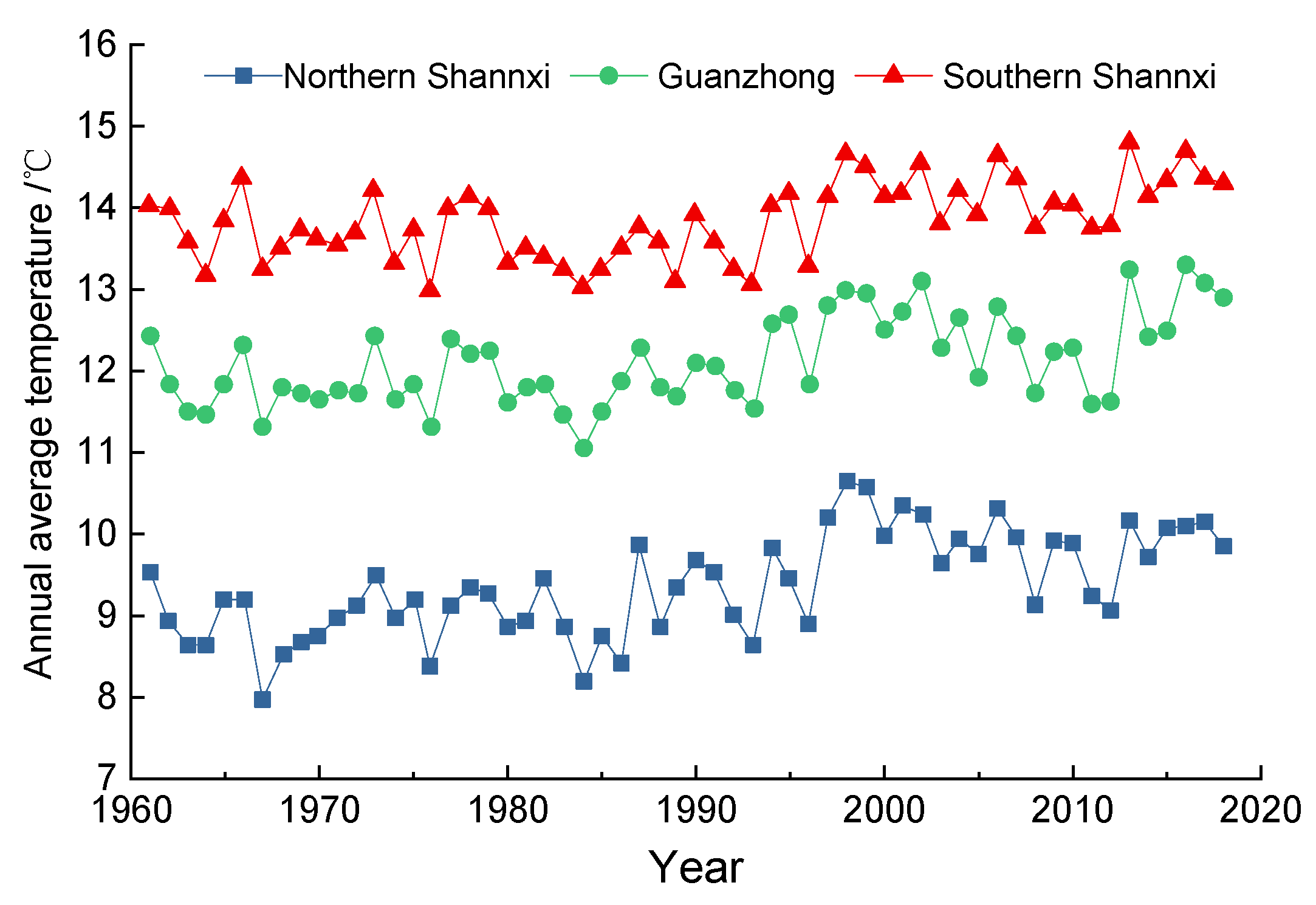
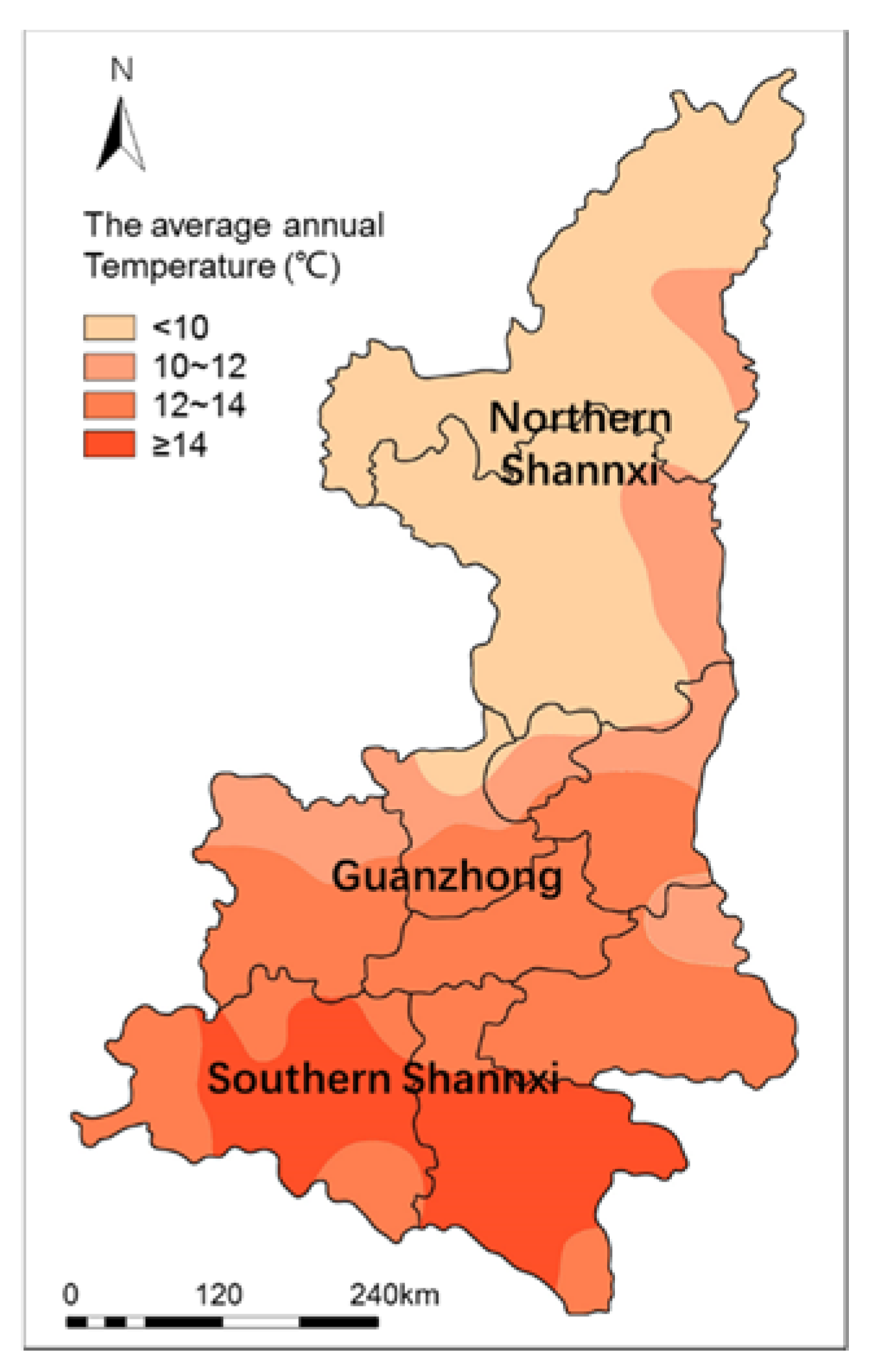
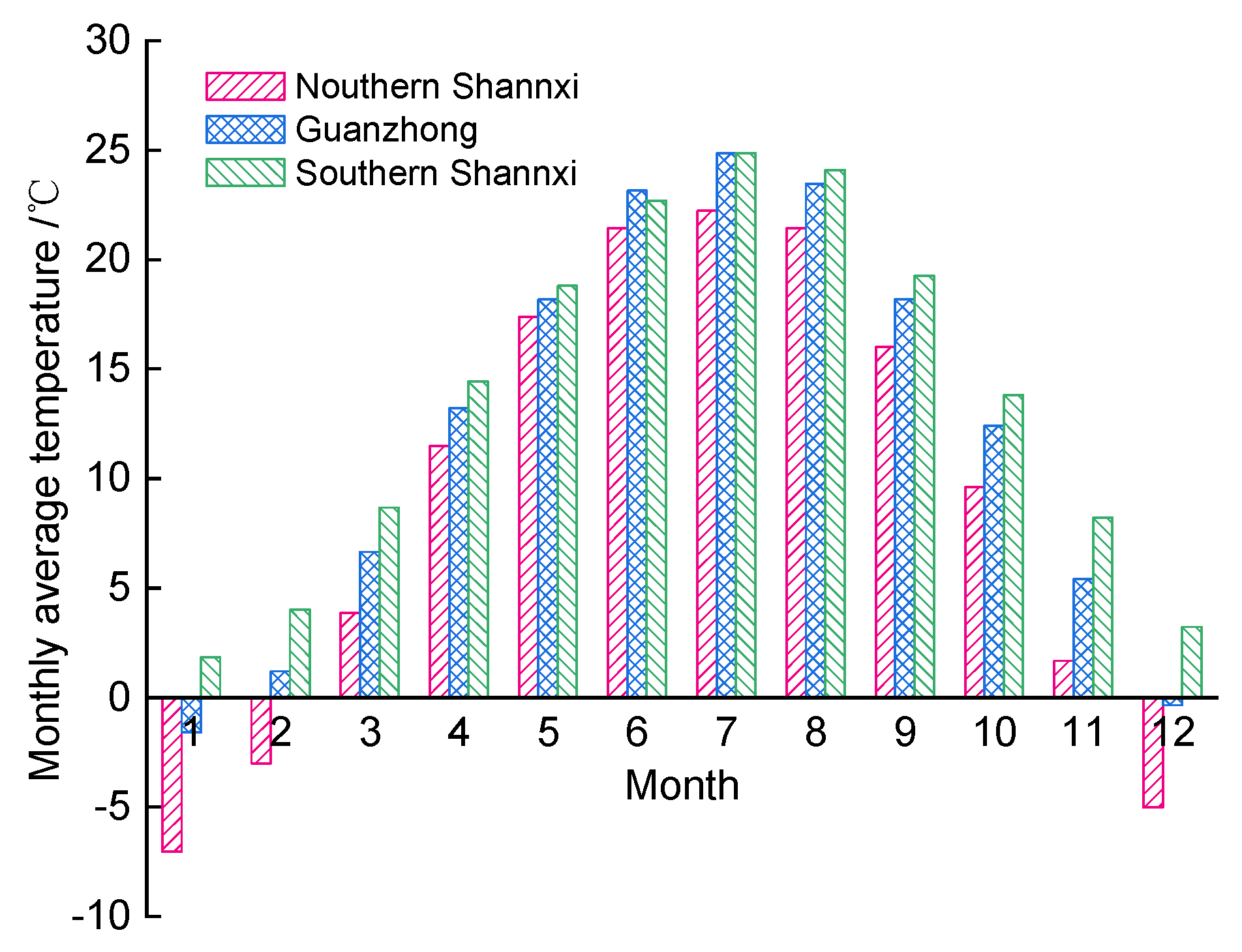
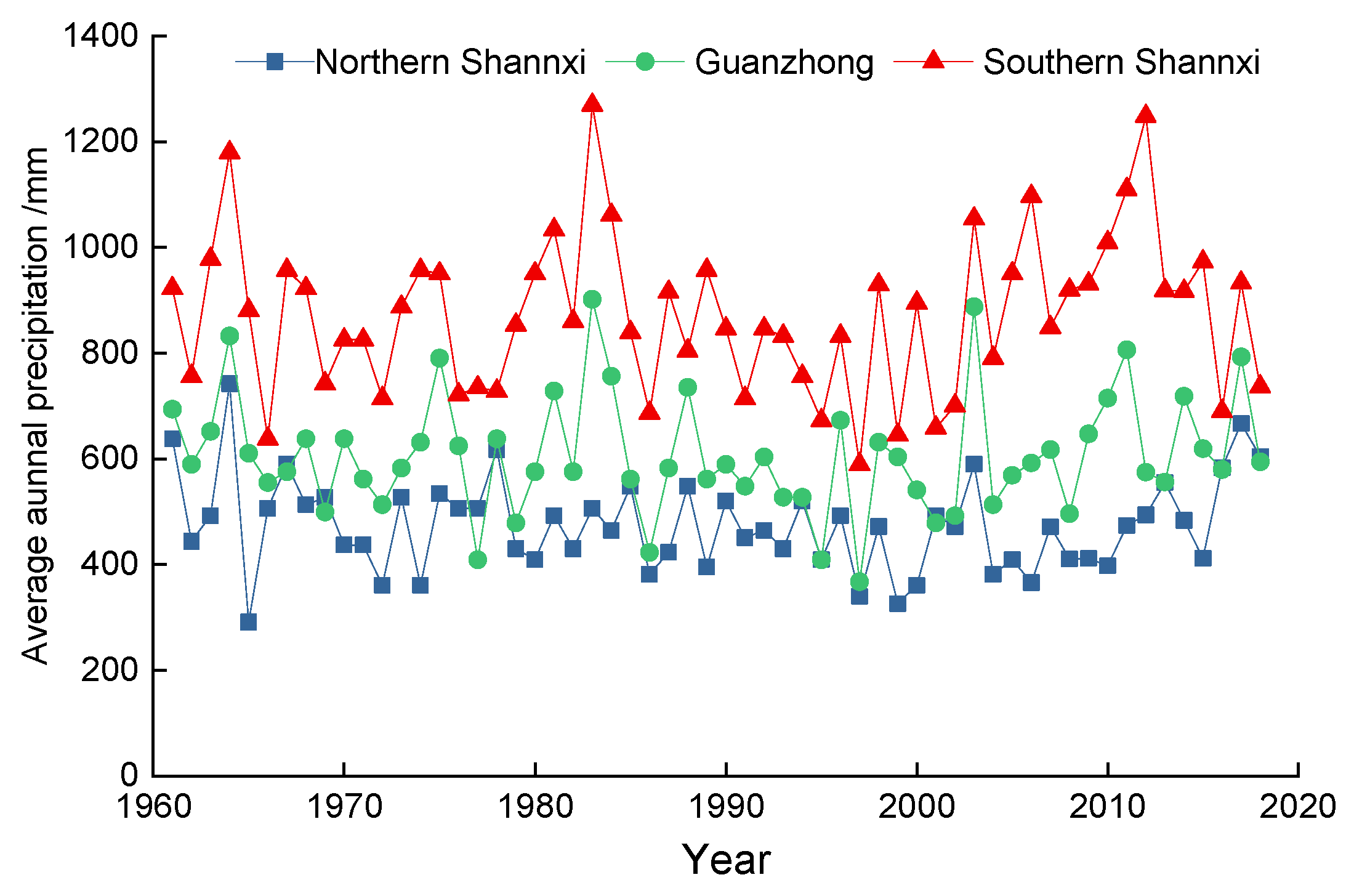
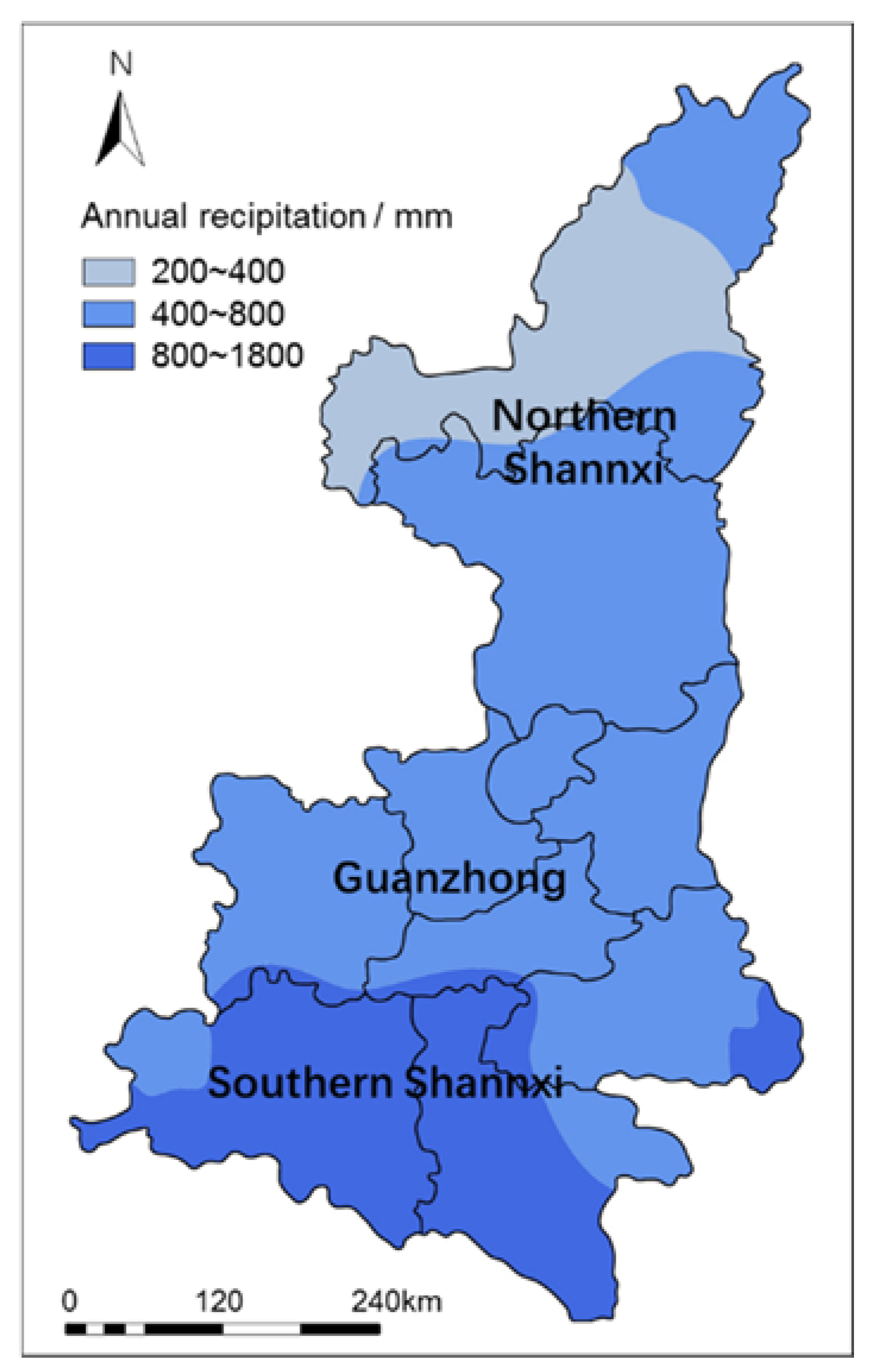
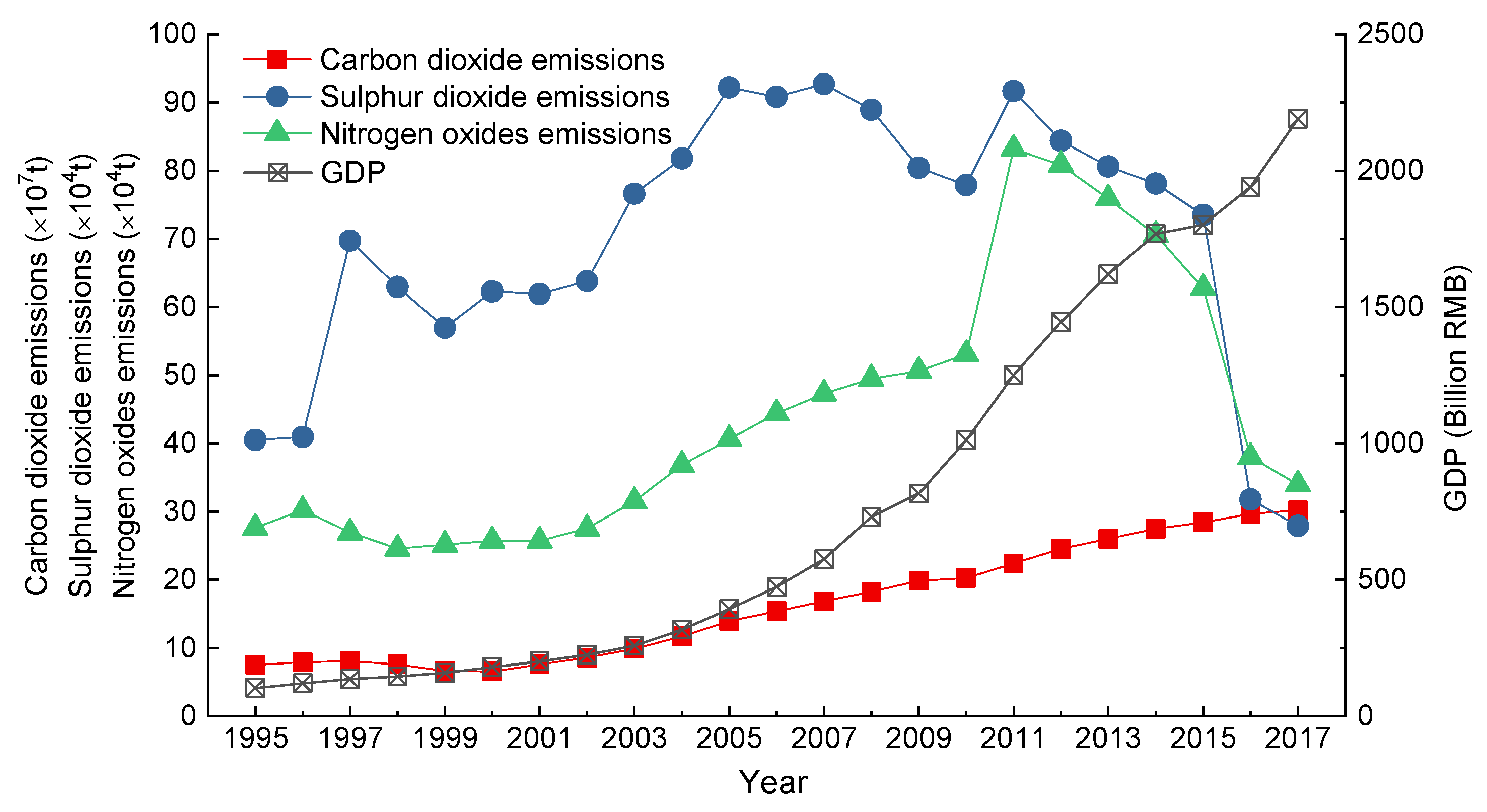
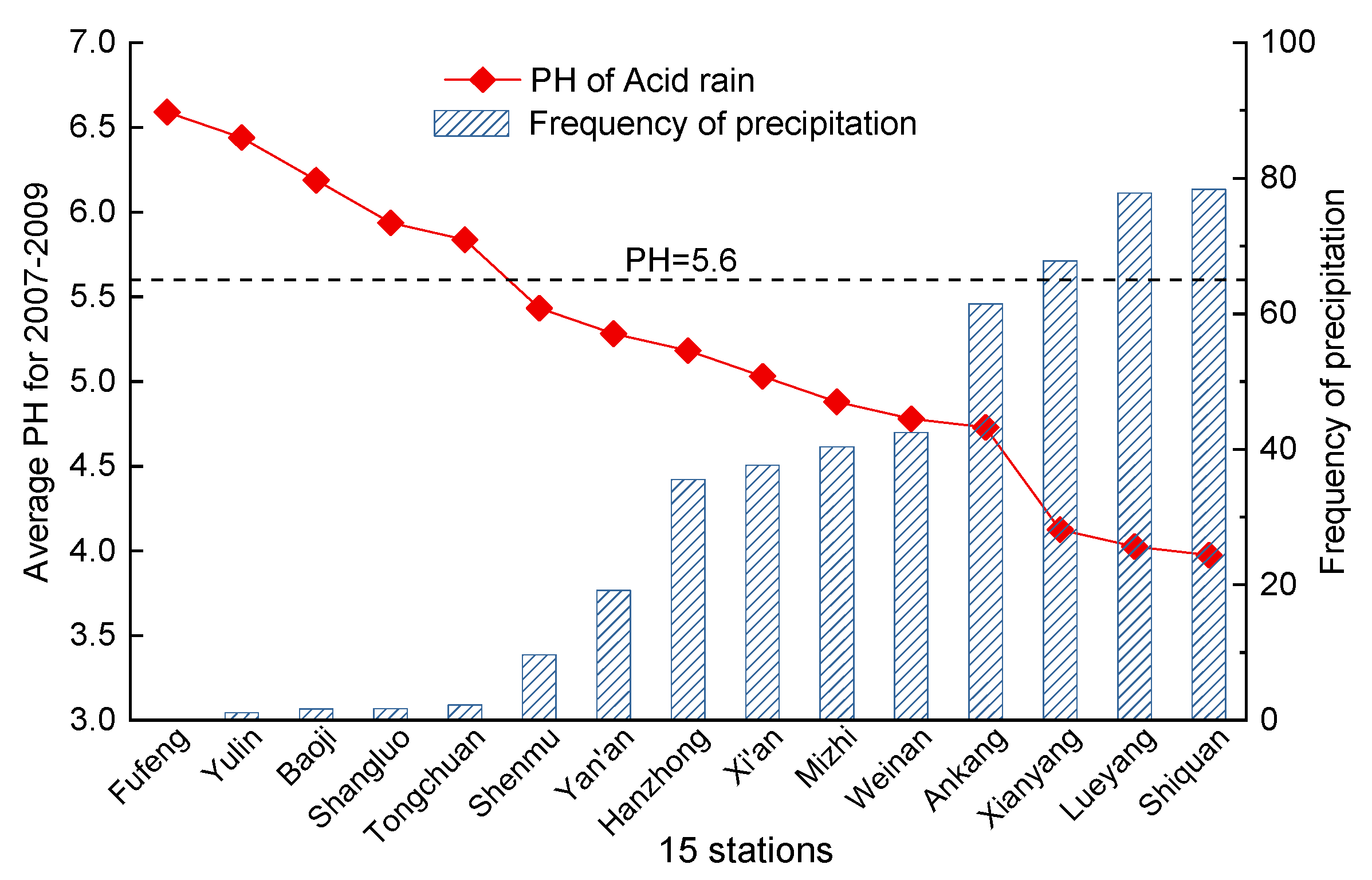

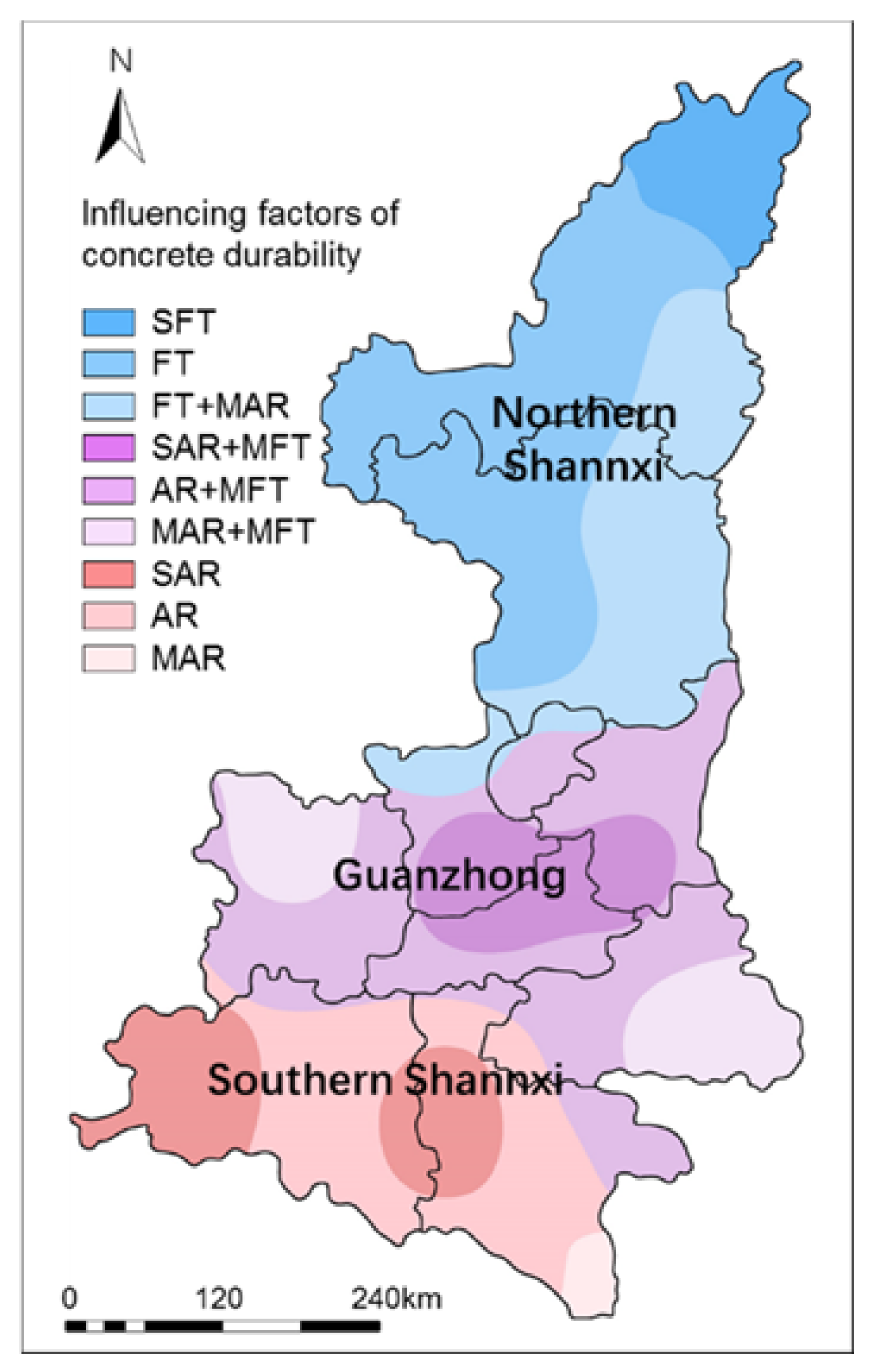
| Region | Mean Value | Standard Deviation | Skewness Coefficient | Kurtosis Coefficient | Range of Variation | Range | Variation Coefficient |
|---|---|---|---|---|---|---|---|
| Northern Shaanxi | 9.24 | 0.62 | 0.374 | −0.245 | 7.97~10.63 | 2.66 | 0.07 |
| Guanzhong | 12.08 | 0.49 | 0.383 | −0.633 | 11.13~13.15 | 2.02 | 0.04 |
| Southern Shaanxi | 13.70 | 0.44 | 0.183 | −0.807 | 12.97~14.61 | 1.64 | 0.03 |
| Sample Number | Indexes of Environmental Zonation for Concrete Durability | ||||
|---|---|---|---|---|---|
| Annual Freeze-Thaw Cycles | Annual Precipitation (mm) | Average Temperature in July (°C) | Annual Acid Rainfall (mm) | Durability Damage Level | |
| 1 | 113 | 574.9 | 23.9 | 91.9 | 4 |
| 2 | 110 | 562.2 | 23.5 | 101.1 | 3 |
| 3 | 106 | 538.9 | 23.3 | 106.1 | 3 |
| 4 | 117 | 567.1 | 23.5 | 97.4 | 4 |
| 5 | 114 | 542.2 | 23.8 | 103.7 | 3 |
| 6 | 114 | 547.6 | 23.5 | 105.1 | 4 |
| 7 | 103 | 515.2 | 23.1 | 113.7 | 2 |
| 8 | 113 | 572.0 | 23.5 | 95.5 | 4 |
| 9 | 108 | 544.7 | 22.8 | 107.2 | 3 |
| 10 | 109 | 546.1 | 24.2 | 102.0 | 3 |
| 11 | 112 | 570.2 | 23.4 | 94.3 | 4 |
| 12 | 106 | 521.3 | 23.3 | 107.6 | 2 |
| 13 | 107 | 505.5 | 23.7 | 112.0 | 1 |
| 14 | 105 | 517.7 | 23.4 | 110.6 | 2 |
| 15 | 115 | 578.5 | 23.6 | 95.3 | 4 |
| 16 | 104 | 505.1 | 23.0 | 111.3 | 1 |
| 17 | 116 | 543.5 | 23.5 | 101.9 | 4 |
| 18 | 108 | 566.8 | 23.2 | 100.8 | 3 |
| 19 | 108 | 510.3 | 23.6 | 111.3 | 2 |
| 20 | 115 | 545.6 | 23.3 | 106.7 | 3 |
| 110 | 543.8 | 23.4 | 103.8 | 3 | |
| 4.37 | 23.69 | 0.30 | 6.33 | 0.97 | |
| Zones | Weight of the Indexes for Environmental Zonation | Typical City | ||||
|---|---|---|---|---|---|---|
| Annual Freeze-Thaw Cycles | Annual Precipitation | Average Temperature in July | Annual Acid Rainfall | |||
| Freeze-Thaw Cycle Zone (Zone I) | Severe freeze-thaw (Zone Ia) 1 | 0.4231~0.5170 | 0.1722~0.2358 | 0.1152~0.1875 | 0.0202~0.2003 | Fugu, Shenmu |
| Moderate freeze-thaw (Zone Ib) | 0.3076~0.4611 | 0.1361~0.2404 | 0.0221~0.1813 | 0.1018~0.2384 | Yulin, Hengshan, Jingbian, Dingbian, Wuqi, Zhidan, Ansai, Ganquan, Fuxian | |
| Moderate freeze-thaw with mild acid rain (Zone Ic) | 0.2845~0.4212 | 0.1533~0.2398 | 0.1421~0.1943 | 0.1592~0.2822 | Suide, Mizhi, Jiaxian, Wubao, Qingjian, Zizhou, Zichang, Yanchuan, Yanchang, Yan’an, Yichuan, Luochuan, Huanglong, Huangling, Changwu, Xunyi, Yijun, Binxian. | |
| Neutralization–Freeze-Thaw Interaction Zone (Zone II) | Severe acid rain with mild freeze-thaw (Zone IIa) | 0.1462~0.2572 | 0.2082~0.2810 | 0.0576~0.1652 | 0.3512~0.4675 | Xi’an, Xianyang, Xingping, Tongchuan, Weinan, Gaoling, Zhouzhi, Huxian, Lantian, Sanyuan, Jingyang, Qianxian, Liquan, Huaxian, Fuping. |
| Moderate acid rain with mild freeze-thaw (Zone IIb) | 0.2195~0.3023 | 0.2124~0.2708 | 0.1199~0.2124 | 0.2764~0.3743 | Baoji, Taibai, Wugong, Qishan, Fufeng, Meixian, Yongshou, Chunhua, Hancheng, Heyang, Dali, Pucheng, Baishui, Chengcheng, Huayin, Tongguan, Xunyang, Baihe, Shangluo, Zhen’an, Zhashui, Luonan, Danfeng, Shanyang. | |
| Mild acid rain with mild freeze-thaw (Zone IIc) | 0.2023~0.2863 | 0.2129~0.2545 | 0.1741~0.2318 | 0.2036~0.3201 | Longxian, Qianyang, Fengxiang, Linyou, Fengxian, Shangnan. | |
| Neutralization Zone (Zone III) | Severe acid rain (Zone IIIa) | 0.1097~0.1948 | 0.1245~0.2941 | 0.0785~0.1088 | 0.4425~0.5249 | Ningqiang, Lueyang, Mianxian, Hanyin, Shiquan, Ningshan. |
| Moderate acid rain (Zone IIIb) | 0.1362~0.2316 | 0.2198~0.3753 | 0.1856~0.2851 | 0.3518~0.4699 | Hanzhong, Liuba, Nanzheng, Chenggu, Yangxian, Xixiang, Zhenba, Foping, Ankang, Ziyang, Langao, Pingli | |
| Mild acid rain (Zone IIIc) | 0.1037~0.1232 | 0.3495~0.3772 | 0.2433~0.2678 | 0.3247~0.4012 | Zhenping | |
© 2020 by the authors. Licensee MDPI, Basel, Switzerland. This article is an open access article distributed under the terms and conditions of the Creative Commons Attribution (CC BY) license (http://creativecommons.org/licenses/by/4.0/).
Share and Cite
Luo, D.; Wang, Y.; Zhang, S.; Niu, D. Application of Fuzzy and Rough Sets to Environmental Zonation for Concrete Durability: A Case Study of Shaanxi Province, China. Sustainability 2020, 12, 3128. https://doi.org/10.3390/su12083128
Luo D, Wang Y, Zhang S, Niu D. Application of Fuzzy and Rough Sets to Environmental Zonation for Concrete Durability: A Case Study of Shaanxi Province, China. Sustainability. 2020; 12(8):3128. https://doi.org/10.3390/su12083128
Chicago/Turabian StyleLuo, Daming, Yan Wang, Shaohui Zhang, and Ditao Niu. 2020. "Application of Fuzzy and Rough Sets to Environmental Zonation for Concrete Durability: A Case Study of Shaanxi Province, China" Sustainability 12, no. 8: 3128. https://doi.org/10.3390/su12083128




